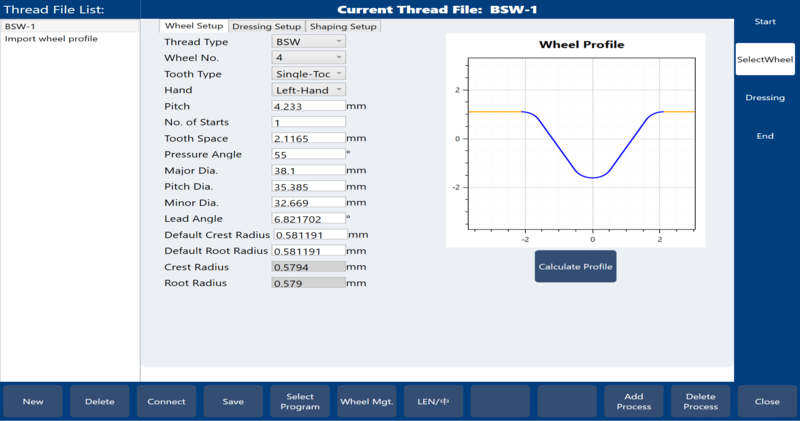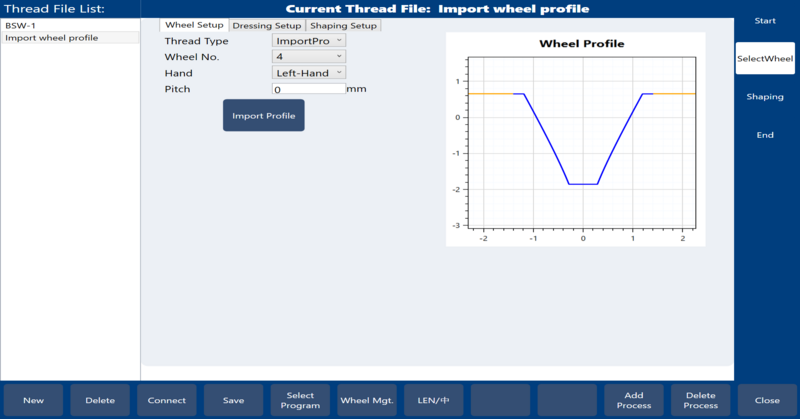Next-Generation Thread Grinding HMI
NUM Taiwan is developing a new Thread Grinding Human-Machine Interface (HMI) tailored for intuitive, precise, and efficient thread grinding operations. Precision thread grinding is a critical process for manufacturing high-quality threaded components like ball screws, worm shafts, and specialty fasteners. To simplify and enhance this process, NUM Taiwan is developing a dedicated Thread Grinding Human-Machine Interface (HMI) as part of its CNC platform. This specialized HMI is being built with a combination of C# programming, macro routines, and PLC integration to provide an intuitive yet powerful interface for thread grinding operations. The goal is to enable operators to program and grind threads efficiently with conversational inputs and guided setup, rather than manual G-coding. In this article, we review the current progress of the NUM Taiwan Thread Grinding HMI, the features it will offer (and those planned), and the updated development timeline, all presented in a polished format suitable for our customers.
Current Focus: Single External Thread Grinding
The initial development focus for the NUM Taiwan Thread Grinding HMI is on single-start external thread grinding. This means the first release will handle threads that have a single helical groove (single-start) on the outside of a workpiece. By concentrating on external threads first, the development team can ensure the core functionality is solid for the most common use cases (such as grinding threads on shafts, screws, and bolts). The HMI provides straightforward input screens where the operator can enter thread parameters (like diameter, pitch, length, etc.), and the system will generate the necessary grinding and dressing cycles behind the scenes. This conversational approach is akin to NUM’s existing NUMgrind software, which uses intuitive fill-in-the-blank dialogs so shop-floor personnel can quickly create G-code programs without extensive CAM knowledge. The new thread grinding HMI follows this philosophy, guiding the user through single thread setups step by step.
Extensive Thread Profile Support
A major highlight of the new HMI is its broad support for different thread shape standards. NUM Taiwan recognizes that customers need to grind a wide variety of thread forms used across industries and regions. The HMI will come with built-in profile definitions for many common fixed thread shapes, including:
- International metric thread system
- American standard thread
- Whitworth thread
- Sharp V thread
- Trapezoidal thread
- Ball screw (Customers have to provide point file)
Beyond this list of standard shapes, NUM Taiwan is also planning a custom thread shape feature for a future release. This would be the ability to import a profile from a CAD drawing - for example, loading a DXF file that contains the cross-sectional outline of a custom thread form. With DXF import capability, users could grind non-standard or proprietary thread profiles by simply drawing the desired shape and letting the HMI convert it into a grind program. This opens the door to virtually any thread form imaginable, ensuring that even unique or specialized threads (for instance, trapezoid variants, special sealing threads, or forms used in aerospace) can be produced. The concept of importing DXF files for custom profiles is already used in some CNC grinding software, and NUM Taiwan will bring a similar convenience to thread grinding. This forward-looking feature underscores NUM Taiwans’s commitment to versatility - giving customers both a rich library of standard threads and the freedom to define their own when needed.
Accurate Thread Profiles Through Smart Dressing Compensation
In thread grinding, the grinding wheel must be precisely dressed to match the thread profile. Challenges arise when the wheel or dresser is rotated at an angle (A-axis rotation), which can distort the profile if not compensated. The new NUM Taiwan HMI solves this with automated dressing profile conversion, adjusting the wheel shape based on the tilt angle to ensure the final thread matches the intended geometry. This compensation is especially important for axis-parallel grinding or machines with limited swivel capability. By calculating these adjustments automatically, the HMI eliminates trial-and-error and ensures high precision - even for complex or internal threads.
User-Friendly Interface & Teach-In Setup
NUM Taiwan is designing its Thread Grinding HMI with simplicity and operator comfort in mind. The interface features a teach-in mode, allowing users to manually guide the machine to key positions - such as thread start, axial zero, or dresser location - and easily save them. This helps streamline setup and reduces the chance of errors, even for less experienced operators. The HMI also includes intuitive menus, familiar terminology, and graphical views to make programming straightforward. Everything is tailored specifically to thread grinding - ensuring clarity, efficiency, and ease of use.
Looking Ahead
Once released, the NUM HMI will offer a powerful, user-friendly tool for accurate, efficient thread grinding. Customers can expect reduced setup times, improved thread quality, and support for a wide range of profiles - from metric and trapezoidal to ball screw threads. With future updates including multi-start and internal thread support, the platform is built to grow with user needs.

